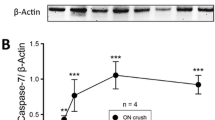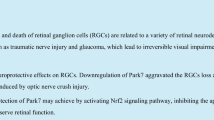Abstract
This study examined the relationship between the distance of axotomy and the death of injured retinal ganglion cells (RGCs) in adult hamsters and the relationship of cytochrome c and caspase-3 on the death pathway of RGCs. The left optic nerve (ON) of adult hamsters was transected either at 1 or 3 mm away from the optic disc, and retrogradely labeled with Flurogold on the ON stump. After a predetermined period of postoperative time, the surviving RGCs were counted by retina flat-mount, and the activation of cytochrome c and caspase-3 were investigated by immunohistochemistry. Cell loss was found to be much faster (P < 0.01), more cells with cytochrome c were observed (P < 0.05) and the activation of caspase-3 was earlier when ON was transected 1 mm away from the optic disc than when was transected 3 mm away from the optic disc. Distance of axotomy affects the axotomized cell death rate where more RGCs died when the ON transection was applied closer to the eye. The timing of activation of caspase-3 in the RGCs may be linked to the distance of axotomy.
Similar content being viewed by others
Author information
Authors and Affiliations
Corresponding author
Additional information
Special issue dedicated to Dr. Lawrence F. Eng
Rights and permissions
About this article
Cite this article
He, MH., Cheung, Z.H., Yu, EH. et al. Cytochrome c Release and Caspase-3 Activation in Retinal Ganglion Cells Following Different Distance of Axotomy of the Optic Nerve in Adult Hamsters. Neurochem Res 29, 2153–2161 (2004). https://doi.org/10.1007/s11064-004-6889-6
Accepted:
Issue Date:
DOI: https://doi.org/10.1007/s11064-004-6889-6




